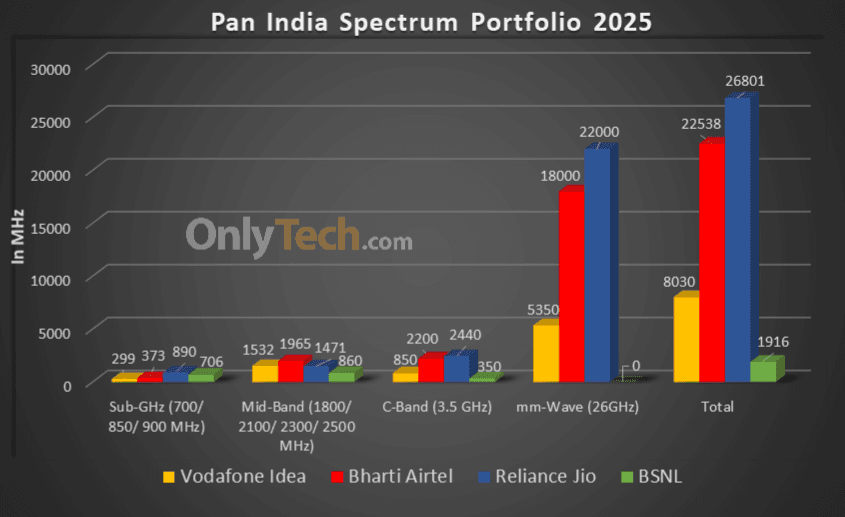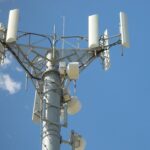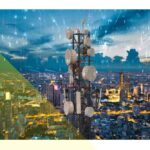Spectrum is for telecommunication what jet fuel is for aviation. Spectrum is a range of electromagnetic frequencies or airwaves that telecom companies use for establishing a connection between a cell tower and a mobile phone. The bandwidth of this spectrum is directly proportional to the speed of a wireless data network (since more data can be transmitted simultaneously through a broader data pipeline). In contrast, the frequency is inversely proportional to the coverage (since lower frequencies penetrate better through physical barriers and thus have wider coverage).
The spectrum holding data sheet embedded in this article represents the current spectrum holdings of all active telecom operators across all frequency bands across all 22 telecom circles along with their liberalisation status and expiry dates. All figures represented are in MHz. The value mentioned in the bracket beside the frequency at the base of each sheet is the band number where ‘B’ stands for 4G LTE band whereas ‘n’ stands for the corresponding 5G NR band.
The spectrum shown under BSNL and Aircel in white is reserved for the respective operators but has not yet been officially allotted to them.
Spectrum Liberalisation:
Spectrum was administratively allocated to operators in each of the 22 licensed service areas or circles prior to 2010, this spectrum is called non-liberalised and can only be used for 2G services whereas all airwaves allotted post-2010 have been through a Spectrum Auction where operators have paid the market discovered price and this spectrum is called liberalised and can be used for any technology platform 2G/3G/4G/5G. Alternatively, operators may choose to liberalise their administratively allotted spectrum by paying the market-discovered price to DoT on a pro-rata basis for the remaining validity of the spectrum.
Paired and Unpaired spectrum:
Spectrum may be paired or unpaired, bands 1/3/5/8/28 are all paired where one set of frequencies is used for uplink whereas another distinct set of frequencies is used for downlink known as Frequency-division duplexing (FDD), whereas bands 40/41/78/258 are unpaired where both uplink and downlink happens in the same set of frequencies separated by the time of uplink and downlink known as Time-division duplexing (TDD).
List of Indian FDD Bands:
| 4G LTE band | 5G NR band | Uplink frequency range (MHz) | Downlink frequency range (MHz) | Bandwidth for telecom (MHz) | Block size (MHz) |
|---|---|---|---|---|---|
| B1 | n1 | 1939-1979 | 2129-2169 | 40×2 | 5×2 |
| B3 | n3 | 1710-1780 | 1805-1875 | 70×2 | 0.2×2 |
| B5 | n5 | 824-844 | 869-889 | 20×2 | 1.25×2 |
| B8 | n8 | 890-915 | 935-960 | 25×2 | 0.2×2 |
| B28 | n28 | 723-733/ 738-748 | 778-788/ 793-803 | 20×2 | 5×2 |
List of Indian TDD Bands:
| 4G LTE band | 5G NR band | Frequency range (MHz) | Bandwidth for telecom (MHz) | Block size (MHz) |
|---|---|---|---|---|
| B40 | n40 | 2300-2380 | 80 | 10 |
| B41 | n41 | 2535-2555/ 2615-2655 | 60 | 10 |
| – | n78 | 3300-3670 | 370 | 10 |
| – | n258 | 24250-27500 | 3250 | 50 |
Spectrum caps:
A spectrum cap dictates how much spectrum a particular operator can hold in a circle for a specific band. There is a 40% cap for Sub-GHz spectrum in the 700/850/900 MHz bands combined, a 40% cap for Mid-Band spectrum in the 1800/2100/2300/2500 MHz bands combined, a 40% cap for the C-Band spectrum of 3300-3670 MHz and a 40% cap for the mm-Wave spectrum bands of 24.25-27.5 GHz. The current spectrum caps are denoted in the spectrum chart.
Overall spectrum holdings of operators (in MHz):
| Operator/Holding | Jio | Airtel | Vi | BSNL |
|---|---|---|---|---|
| Sub-GHz | 890 | 373.2 | 298.8 | 706 |
| Mid Band | 1470.8 | 1964.9 | 1531.6 | 860 |
| C-Band | 2440 | 2200 | 850 | 350 |
| mm-Wave Band | 22000 | 18000 | 5350 | 0 |
| Total | 26,800.8 | 22,538.1 | 8,030.4 | 1,916 |
Spectrum sharing/trading/leasing guidelines:
- Telecom operators holding CMTS/UASL/UL licenses can enter into a Spectrum-Sharing agreement with each other so long as both parties hold liberalised spectrum in the same band in the same circle. Spectrum sharing is possible only on a Pan LSA level in block sizes defined by DoT and only after one year of an operator acquiring the spectrum.
- Telecom operators holding CMTS/UASL/UL licenses can enter into a Spectrum-Trading agreement with each other so long as the spectrum being sold is liberalised. Trading of spectrum is possible only on a Pan LSA level in block sizes defined by DoT and only after two years of an operator acquiring the spectrum.
- Telecom operators may enter into a Spectrum-Leasing agreement only with Enterprises holding a Captive Non-Public Network (CNPN) license and not with each other. The lease may be limited to any geographic area within the LSA and for any duration mutually agreed upon by both parties. A CNPN licensee can lease spectrum from multiple operators within an LSA.
Note: We update this chart in real-time to ensure it is always up to date with the latest changes in spectrum holding. Certain human errors might have crept in during the manual compilation of the data, any mistakes/ rectification can be brought to the Team’s notice through the comments section below.








@esmail Don’t you think that 5G scam happening in india ? Smartphone OEMs are giving just one 5G band n78. Some give n77 ⬅️ i think this band won’t be used. N41 only vi owns this. Why don’t they give n40 (op band) and the band which are being used like n5,8,3,1. In future may be n28 be used. Are they doing it intentionally to make profit or they don’t visit onlytech website ? In other countries they give much more bands than required.
Even in the case of 4G, before Jio launched LTE on band 5 you didn’t have any handset which offered band 5 LTE, but once they launched, every manufacturer made sure their device supported it.
So it’s not a scam it’s just smart marketing, by adding n71 the phone is technically classified as 5G compliant because currently no operator has launched 5G on any band, so the layman will opt for the 5G phone instead of going for a 4G phone at the same price point.
Eventually when operators launch 5G then the manufacturers will include those bands in their phones, but more the number of supported bands, higher will be the price of the handset.
Does smartphone OEMs have to pay royalty to SoC makers say Qualcomm to enable more 5G bands ? Also why samsung and Motorola are giving 11-12 5G bands which includes current bands and also popular bands ? Op 9 pro has just 1 or 2 bands of 5G the most expensive phone of op ?
@esmail (1.)Spectrum was administratively allocated to operators in each of the 22 licensed service areas or circles pre 2010, this spectrum is called non-liberalised . DOES IT MEAN THAT OPERATERS WERE GIVEN SPECTRUM FOR FREE ? ALSO WHICH BANDS FALL IN NON LIBERALISED SPECTRUM ?
(2.) Is spectrum in a particular frequency band limited as in B5 it is 17.5Mhz for telecom. Does all country who are using B5 have 17.5Mhz of spectrum ?
(3.) Does as we move towards higher frequency the spectrum (bandwidth) availability increase ?
(4.) What would the spectrum availability in 5G mm waves ?
1) Yes, administratively allotted Spectrum was given bundled along with the license fee and no additional charge was levied for it. Spectrum in bands 3,5,8 were allotted administratively pre 2010. All spectrum in 850 MHz band is now liberalised while some spectrum in the 900 and 1800 MHz bands is still unliberalised and will expire over the next 5 years.
2) No this will differ from country to country, the maximum available bandwidth in band 5 can be up to 25 MHz but in India we have 17.5 MHz available as 2.5 MHz is reserved for the defence and 5 MHz is given to band 8 in the overlapping region.
3) see every GHz has a 1000 MHz in it, whether you consider the low end of the spectrum or higher end. It’s all about how much bandwidth is dedicated to each band. In lower frequency bands ITU has allotted lesser bandwidth whereas in the high frequency bands it has allotted more bandwidth.
4) in millimetre wavelength bands u will have the 26 GHz and 28 GHz bands. I will update the bandwidth for telecom depending upon trai recommendation and what Dot finalises in its 5G auction NIA.
Thank you